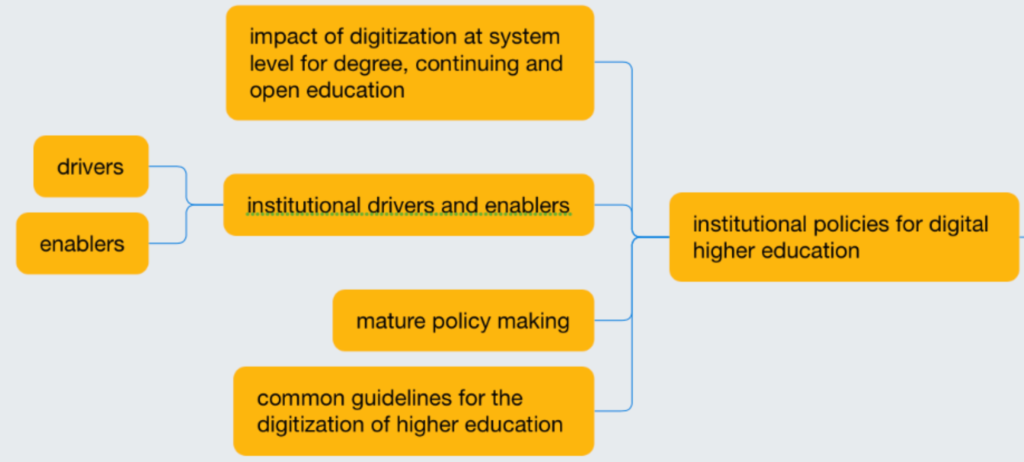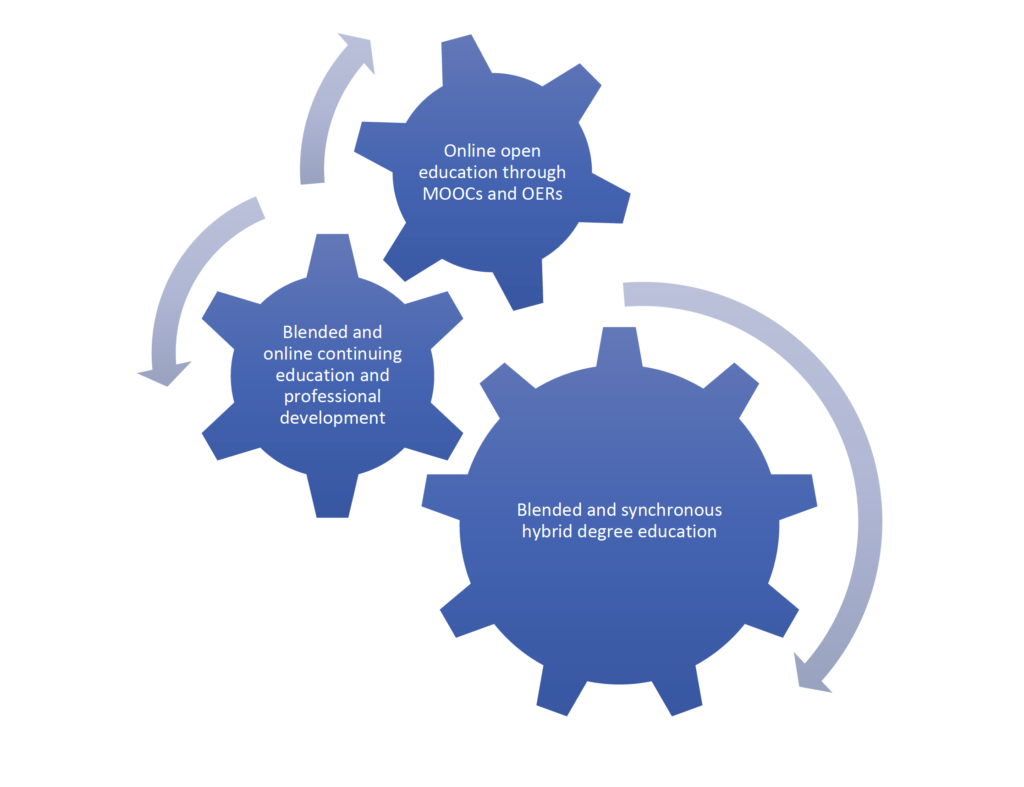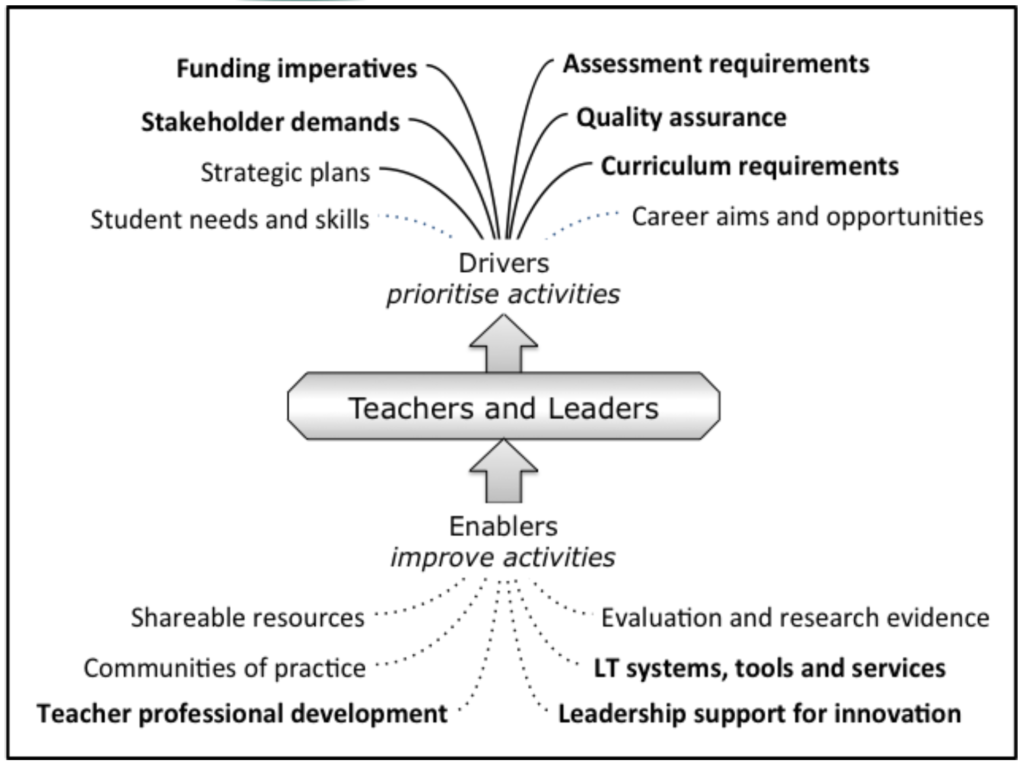
Policies, strategies and frameworks for digital higher education are to be developed by each institution (fig.27):
- having an impact at system level for degree, continuing and open education;
- promoting drivers and enablers for systemic change for digital innovation;
- assuring mature policymaking based on valid information and evidence;
- common guidelines for the digitization of higher education.
After COVID, higher education institutions are aware that digital higher education policies are not only necessary for possible new crisis scenarios, but that digital higher education is now experienced as the ‘new normal’ by learners and teachers.
Institutional developments with regard to digital learning now have to be accelerated by institutional
strategies and policies and led to the system level, activating bottom-up innovation processes with an
institution-wide impact (SURF, 2022). Governments can support this acceleration process by
stimulating and activating innovation by funding mechanisms.
The digital innovation that has taken place in higher education before COVID was done by individual
academic teachers and leaders, rather than by a coherent national or institutional strategy. Successful
innovations remained patchy and localized, not systemic and sustainable. Also in a systemic policy
approach, it is key to give education professionals “time to innovate, develop, test and share what they
did” (Laurillard, 2015).
Impact of digitization at system level for degree, continuing and open education
Three areas of provision are emerging in higher education: degree education, continuing education and
professional development, and open education. Educational technology has an impact on all three
areas. As more flexibility is needed for off-campus students to increase access and scalability through
place- and time-independent learning, this impact will be greater in the areas of continuing and open
education (fig. 28).
As a result, institutional technology-enhanced educational frameworks might evolve as:
- synchronous hybrid and blended degree education as the backbone of educational offerings,
mainly for campus-based students; - blended and online distance continuing education and professional development, including
micro-credentials with both an academic and professional orientation, mainly for off campus
students whose numbers will increase and possibly exceed those of degree education, due to
the needs on the labour market and in society at large. - online distance open education in the public domain with MOOCs and OERs, for off campus
learners
Frontrunner universities are active in all three areas. In most countries, continuing education and open
education are not yet well developed, although these sectors should become part of every higher
education system. Higher education institutions are seeking policies and strategies to define their
profile in these areas, which can complement each other and be intertwined to some extent (Haywood
et al., 2015). Institutional digitization policy can differ in these three areas of the offer, which has consequences for the teaching and learning models used.
The development and delivery of these different areas of provision also requires different types of
organization. For continuing and open education, this includes collaboration and co-creation with
external stakeholders and specific course design support, in addition to another relationship with
students who only take short courses or microlearning units at perhaps long intervals.

degree education, continuing education and professional development and open education
These systemic developments should be stimulated and activated by national governments as part of
the Bologna process to accelerate strategic efforts and developments in all European countries.
Institutional drivers and enablers
Successful implementation of institutional digitization policy requires a different system and change
management. Leadership should encourage and enable teaching staff and other professionals at all
levels of the institution to achieve the objectives of the institution in the interest of the learners.
Higher education institutions are complex systems. For a clear understanding of the system, Laurillard
has described drivers and enablers for technology-based innovation (Laurillard, 2015).
Drivers
Drivers are elements in the system that determine how leadership and teaching staff at all levels are
likely to prioritize innovation activities. Drivers are influences that leadership and professionals in the
system cannot ignore:
- stakeholder demands: students, teachers, higher education institutions, policymakers and
governments recognising the benefits and opportunities digital education and demanding changes; - funding imperatives: developing viable and scalable costing and investment models for digital
education, funding for leading innovators and adopters; - strategic plans: governmental and institutional aims and objectives specifying clear targets and
investment in teaching and learning innovation through digitization, engaging the entire
organisation; - curriculum requirements: embedding digital competences required in all curriculum areas,
including 21st century skills, across all curriculum areas; - assessment requirements: using the potential of technology in the formative and summative
assessment of attainment levels in knowledge and skills; - quality assurance: related to the degree of digital teaching innovation;
- students’ individual needs and skills: responding to the diversity of students, using technology for
flexible access, increasing student readiness for digital education; - teachers’ career opportunities: rewards for teaching excellence, stimulating personal motivation
of the teachers who redesign their teaching.
Fig. 29 shows how academic teachers and leaders are likely to prioritise activities. Leaders and
professionals in an institution prioritize their work guided by the comparative power of the competitive influences of the drivers. Drivers are factors that determine the success of change and innovation initiatives.

innovation in learning technology (bold indicates the more powerful ones) (Laurillard, 2012, 2015)
Responsibility for the drivers is usually divided between the institutional and governmental level of
policy. None of drivers are completely under the control of the institutions. All levels should contribute to innovation and digitization strategies in higher education to make changesystem-wide.
The COVID crisis had a huge impact on these drivers, especially on funding and budgeting related to
education technology infrastructure and resources, strategic plans on technology and innovation,
curriculum and assessment requirements, and responding to student needs. This impact needs to be
further improved and consolidated in the coming years. This is also supported by the European Digital
Education Action Plan.
Enablers
Enablers are the factors in an institution that support teachers and leaders in the change process:
- leadership support for innovation: a central vision/concept, strategy and resources; digitization
making education higher quality, scalable, affordable; giving teachers the time and encouragement
to innovate; - teacher professional development: continuing professional development to update knowledge and
skills of learning technology, incentivize and reward innovative pedagogies as part of professionalism; - learning technology tools, systems and services: sustainable provision of learning technology
infrastructure, tools and resources, and related teaching staff support; - communities of practice: supporting teachers to exchange teaching ideas and practices, ways of
using new technology, and opportunities for peer evaluation and review of innovative practice;
creating subject-bound or cross-cutting groups; publish patterns of good practice of course design
in the institution and outside; - shareable resources: promoting the development of and access to open educational resources and
learning design tools, to reduce the costs of innovation and enable teachers to build on each other’s
work; - evaluation and research evidence: funding studies to provide evidence, design principles and
results to inform practice; continuously evaluate strategies, frameworks and conditions for
improvement; use maturity and quality assurance instruments for digital education.
At the top of the list of enablers is leadership, which should be shared at all levels of the institution.
Leadership should ensure that all institutional leaders, teaching staff and prrofessionals are in place to
support digital education.
Institutional leadership is responsible for developing enablers. This responsibility can be shared or
supported in inter-institutional initiatives, (international) associations, quality assurance agencies, and
other agencies funded by government such as SURF in the Netherlands, the National Teaching and
Learning Forum in Ireland or JISC in the UK.
Mature policy making
In the EMBED maturity model, institutional policies refer to leadership, strategies and conditions related to the organization and support of digital learning. Various key actors, teams or agencies play a role in the decision-making process, including programme coordinators, deans, and central and decentralized educational and ICT support services (see also section 3 of this eBook) (Dijkstra and Goeman, 2021).
Evidence-based policy guidelines for digital education are based on innovation models based on sound
theories, scientific results and continuous evaluation in interaction with stakeholders. The extent to
which iterative quality improvement processes are embedded in an institution determines the maturity
level of digital policies and leadership. If supported by research and/or practical evidence, institutional
policies can be legitimized and strengthened.
In this EMBED maturity model, the institution level consists of the following eight dimensions:
- institutional strategies and leadership for innovation and digital education (evidence-based
policy making) - institutional support by institutional frameworks for innovation and educational and
technological support services; - sharing and open practices through communities of practice (in subject areas or transversal)
- professional development and awards for staff
- quality assurance of digital education, including regular institutional evaluation of digital
innovations; - governance embedding policies, rules, regulations, action plans and guidelines related to
digital teaching and learning learning in the standard governance structure of the institution; - finance and budget allocations for innovation and digital education ((grassroot funding, seed
money, project funding - facilities in the learning environment, infrastructure and tools for digital indication.
Maturity levels and Implementation guidelines for each of these dimensions are published on:
https://embed.eadtu.eu/download/2517/EMBED%20implementation%20guidelines.pdf?inline=1
The Common Guidelines for digitalization in higher education (POWERHEAD)
The ‘Common Guidelines for Digitalisation in Higher Education’ aim to provide guidance to enhance
digital learning in higher education, and to help shaping a long-term policy on digitalisation post-
COVID-19. They are the result of the POWERHEAD project coordinated by the Flemish Department
of Education and Training with as partners the Flemish Education Council and the Latvian Ministry of
Education and Science.
The guidelines are developed to respond to following questions:
- How can digital learning in higher education be stimulated?
- How can national authorities support higher education institutions on digital learning, given their autonomy?
- How can higher education institutions further shape their digitalisation policy?
The guidelines are meant to help shaping a long-term policy on digitalisation post-COVID-19. They
are the result of an intensive collaboration between the partners and the experts, and furthermore of
consultations with several ministries and higher education institutions across Europe.
They are structured in two ways:
In the first part, recommendations are divided per theme, respectively vision and policy, including
quality assurance mechanisms; digital skills and readiness; students; course and curriculum design;
funding and infrastructure, and cooperation and stakeholders.
Recommendations regarding educators and teaching staff are incorporated throughout the whole
document.
In the second part, the recommendations are clustered in an abridged form per actor, including higher
education institutions, national/central governments and the European level.
Each of the recommendations is further elaborated in detailed guidelines.
Vision and policies
Develop a robust and solid long-term vision and strategy on digitalisation in higher education. Set
goals in accordance with the vision and devise plans on how to reach those goals. Streamline the
vision at various levels within the higher education institutions, at regional, national and European
level.
Implement policy plans according to the principles of proper change management. This implies,
among other things, focused communication and clear messages, empowering and supporting change
agents within the institution, paying attention to resistance and the psychological acceptance of
change.
Embed digitalisation in regular quality assurance systems and use existing frameworks at institutional,
national and European levels.
Digital skills and readiness
Identify basic and advanced digital and self-regulating skills and competencies that students
need to obtain during their studies. Build further on the attainment goals of compulsory education and on the skills that incoming students already have acquired.
Measure and monitor ‘digital readiness’ of new students. Improve and sharpen the digital literacy of
students if necessary. Structurally embed the development of digital skills and self-regulation skills
within the curriculum.
Ensure support for the continuous professional development of educators. Develop a targeted, planned
system for the specialized professionalisation of educators. Offer technical and didactic support and
facilitate mutual exchange.
Ensure that there are sufficient educators and support staff with a profile that allows for further
enhancement of the implementation of digitalisation in higher education. Valorise the effort and time
educators invest in digitalisation.
Student involvement and well-being
Stimulate communication, commitment and participation of students in policy making on digital or
blended education.
Pay attention to students’ mental well-being, in particular in periods when there is intensive digital
education and the social cohesion and social contact are under pressure.
Implement an accessible, flexible and adaptive digital and/or blended offer for the diverse student
influx in higher education: working students with a part-time job in higher education, students with a
disability, students with a low socio-economic status, etc. Consider and use inclusion as a driver for
digitalization.
Course and curriculum design
Develop a well-considered course and curriculum design, based on pedagogical-didactical principles,
in order to reach a more long-term redesign of education and curricula.
Ensure high-quality assessments and feedback in digital environments.
Funding and infrastructure
Guarantee continuous and adequate core funding of higher education in addition to sufficient resources that are allocated specifically for digitalisation and digital innovation in higher education.
Guarantee the availability and accessibility of (digital) infrastructure (basic equipment such as a computer, an Internet connection, a quiet place for studying).
Cooperation and stakeholders
Guarantee the availability and accessibility of (digital) infrastructure (basic equipment such as a computer, an Internet connection, a quiet place for studying).
Focus on cooperation with various relevant partners, such as players from the labour market.
Develop a balanced relationship with the EdTech sector. Cooperation is important, but higher education institutions cannot be fully dependent on their software and hardware providers. A certain level of independence is needed.
As a higher education sector, pay attention to various legal aspects linked to digitalization, such as
privacy, data security, copyright and intellectual property rights.
For each theme, detailed guidelines are available on the website mentioned above (Vlaamse
Onderwijsraad, 2022).
next chapter: References
previous chapter: Quality assurance for digital education
back to overview: Models and guidelines for the design and development of
digital teaching and learning in higher education
